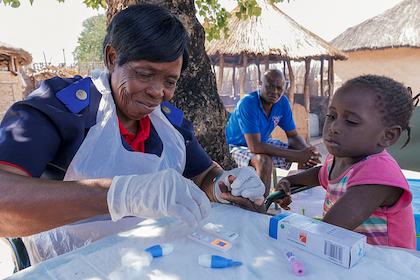New strategies significantly cut disease in challenging low-transmission settings

Credit: UTSW
DALLAS – April 29, 2020 – Strategies that treat households in the broad vicinity of a recent malaria case with anti-malarial drugs, insecticides, or both could significantly reduce malaria in low-transmission settings, a challenge with approaches currently in use, a study led by UT Southwestern scientists suggests. The findings, published in the April 25, 2020, The Lancet, could bring efforts to eradicate malaria worldwide closer to fruition.
Malaria, a mosquito-borne disease that annually infects more than 200 million people and kills nearly 400,000, used to exist in almost every inhabited location on Earth. However, explains Michelle S. Hsiang, M.D., a Horchow Family Scholar in Pediatrics at UT Southwestern Medical Center, tremendous strides have been made in efforts to eliminate malaria in countries and worldwide, which accelerated in the early 2000s with the aid of more intensive efforts and new tools such as drugs and insecticide-treated bed nets.
Although many countries are very close to completely eradicating malaria, it continues to linger at low levels in some locations, emerging as outbreaks with the rainy season every year. The strategies that have been successful at decreasing malaria in high-transmission settings don’t work as well in these low-transmission ones, says Hsiang, assistant professor of pediatrics.
“These countries are left with the challenge of, do we keep doing business as usual, or do we do something different to interrupt transmission and potentially eliminate this disease?” she says. “That requires a different and more aggressive approach.”
Some countries have approached this challenge using a strategy called reactive case detection (RACD), in which people in the immediate vicinity of a positive case are also screened and treated with anti-malarial drugs. However, says Hsiang, because the sensitivity of malaria tests is low, this strategy hasn’t proved effective. On the opposite end of the spectrum, the World Health Organization recommends mass drug administration (MDA), treating all individuals in an endemic area with anti-malarial medications. But this strategy is expensive and can be difficult for large populations to accept.
Seeking a compromise between these two approaches, Hsiang and her colleagues from University of Namibia; University of California, San Francisco; London School of Hygiene and Tropical Medicine; and Wits University tested strategies in which those in close vicinity to a positive malaria case – 500 meters from the positive household – received anti-malarial efforts: either medication (a strategy known as reactive focal mass drug administration, or rfMDA), insecticide spraying (a strategy known as reactive focal vector control, or RAVC), or both. The administered drug was artemether-lumefantrine, a drug with a long history of safe use. The insecticide was a new organophosphate known as pirimiphos-methyl, which can be effective for up to a year when sprayed on the walls and ceilings of affected homes.
The researchers chose the Zambezi Region of Namibia in Africa, a low malarial transmission setting, to study these interventions from Jan. 1 to Dec. 31, 2017. They randomized 56 areas within this region to receive either RACD, rfMDA, RAVC, or a combination of rfMDA and RAVC. As soon as anyone in these areas tested positive, a mobile response team was dispatched to these locations to administer the assigned intervention. By the end of the study, 1,150 of these index cases triggered 342 interventions that covered 8,948 individuals. The researchers then followed the malarial caseload in these areas over the next few weeks and months.
Their results showed that rfMDA and RAVC cut the rate of new cases by 50 percent in each area where they had been administered compared with areas that received RACD. When the researchers administered rfMDA and RAVC in combination, the effect was additive, decreasing new cases by 75 percent.
Residents in each area found these interventions acceptable, Hsiang says, with few refusing to participate. In addition, the interventions appeared safe, causing no serious adverse events. Together, Hsiang says, these findings suggest that rfMDA and RAVC, separately or together, could offer hope to significantly reduce or potentially eliminate malaria in low-transmission settings and facilitate worldwide eradication.
“A child dies from malaria every two minutes, mostly in poor countries,” Hsiang says. “We have the tools to get rid of this disease for good. We just need to learn how to wield them effectively.”
###
Researchers from UTSW who contributed to this study include Brooke Whittemore and Patrick McCreesh.
This study was supported by the Novartis Foundation (A122666), the Bill & Melinda Gates Foundation (OPP1160129), and the UTSW Department of Pediatrics Horchow Family Scholarship (5300375400).
About UT Southwestern Medical Center
UT Southwestern, one of the premier academic medical centers in the nation, integrates pioneering biomedical research with exceptional clinical care and education. The institution’s faculty has received six Nobel Prizes, and includes 25 members of the National Academy of Sciences, 16 members of the National Academy of Medicine, and 14 Howard Hughes Medical Institute Investigators. The full-time faculty of more than 2,500 is responsible for groundbreaking medical advances and is committed to translating science-driven research quickly to new clinical treatments. UT Southwestern physicians provide care in about 80 specialties to more than 105,000 hospitalized patients, nearly 370,000 emergency room cases, and oversee approximately 3 million outpatient visits a year.
Media Contact
Newsroom
[email protected]
Original Source
https:/
Related Journal Article
http://dx.




